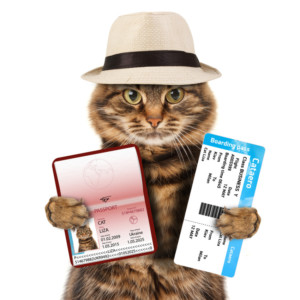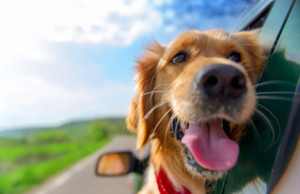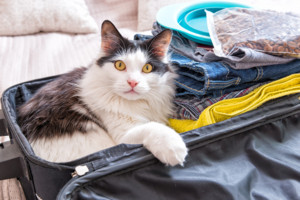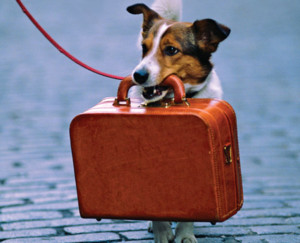As the holiday season is upon us, more and more families consider the option of traveling with their pet versus leaving them in a boarding facility or utilizing an in-home pet sitter. While all 3 are valid options, it’s important to take each specific pet’s needs into consideration before deciding! Since the care of your furry, feathered, or scaly family members is of paramount importance, we’ve put together a handy-dandy checklist to help you decide what is best for YOUR pet, and determine what you need to make a trip with Fido run as smoothly as possible.
First things first, think about your pet. Do they have specific behavioral or medical needs that would make it unsafe for them to travel by plane? This rules out a lot of pets! For example, dogs with short snouts or cats with cardiac health problems, or pets with generalized anxiety typically do not travel very well. It is either unsafe or extremely stressful to stuff these pets into carriers, and put them on a giant metal tube that goes up in the sky! For these guys, the reality is plain: you’ll have to think of an alternative. Think about either driving to your destination, or finding a boarding facility or reliable pet sitter to leave your pet with while you’re away.
If you’ve determined that it is safe for your pet to travel with you, it is important to get a couple of housekeeping items squared away before you leave – whether you’re leaving by plane, train, boat, or car.
Firstly, ensure your pet has UTD tags, and that those tags are always on your pet. An ID tag doesn’t do anybody any good if your dog or cat is never wearing their collar! Secondly, for good measure, make sure your pet is implanted with a registered microchip. Again, identification is useless unless it is registered with accurate information! Thirdly, ensure your pet is UTD on their vaccinations, and travel WITH their medical paperwork. A lot of hotels and travel accommodations require proof of vaccination for all pets. Additionally, if god-forbid you were to end up at an emergency vet on your trip, it will save everybody time and money knowing that a pet is fully vaccinated. If you are traveling across continental borders, many checkpoints require a health certificate signed by a veterinarian. Be sure to do your research BEFORE you leave for your trip, so that you don’t get stuck anywhere, unable to pass through with your pet. And finally, be sure that your accommodations are pet friendly! Many hotels, motels, hostels, etc. are “pet friendly” with restrictions. For example, many hotels have pet deposits, weight restrictions, or breed restrictions. Always call ahead to ensure that the places you’ve booked will be accommodating to your pet! In short, triple check with your travel company and housing accommodations to ensure your pet is welcome.
OK, so you’ve determined your pet is fit to travel with you… what’s next? Pack their bags! Pets travel with a LOT of gear, as it is important to keep them as comfortable and close to their usual routine as possible. When you’re packing the care or the bags, keep these things in mind:
For You:
- Your vet’s contact information
- A list of 24-hour emergency vets in the area you’re traveling to
- The number for National Animal Poison Control (888-426-4435)
- A current color photo of your pet
- Relevant medical records
- Certificate of Veterinary Inspection (your pet’s health certificate)
- Acclimation certificate for air travel (this is only required for some airlines, so double check with yours)
For Your Pet:
- Medications
- Collar, leash, harness (as needed for the specific species)
- Crate or carrier (there are a lot of fantastic “pop-up” options for travel!)
- Bed/blankets
- Toys
- Food and fresh water
- Bowls
- High value treats
- First Aid Kit
To be extra-sure you’re prepared, make yourself a checklist and bring it with you! Check it before you leave every place.
If you’re one of the brave souls who has decided to take on air travel with your pet in tow, here are a few tips to keep in mind:
- Check with airlines before booking, as each has different restrictions and requirements
- Most airlines require a health certificate that was issued within 10 days of travel
- Federal regulations require a pet to be at least 8 weeks of age before flying
- It is typically recommended that pets fly on an empty stomach, but speak to your vet before making any determinations yourself!
- You should make reservations for yourself and your pet at the same time, as most airlines limit the number of animals allowed on each flight
- Do your best to book a non-stop flight to avoid stress in plane changes
- Do your best to avoid flying during busy holidays – try to book flights a few days before and after the busiest days
- In warm weather, choose early morning or late evening flights
- In colder weather, choose midday flights
- Reconfirm flight arrangements the day before departure to avoid last minute changes
On the day of your flight:
- Arrive at the airport early enough to exercise your pet and allow them to eliminate
- If your pet will be in the cabin, check in as late as possible to reduce he time your pet will have to wait in the terminal
- place your pet in its crate and pick it up as soon as you arrive at your destination
- Notify the flight attendant if your pet is in cargo
- NEVER allow your pet to be placed in an overhead bin – confirm regulations and policies with the airline and your vet ahead of time and ADVOCATE FOR YOUR PET
So there you have it! We hope these tips make for a safe and easy travel season, and if you need to find a pet sitter, give us a call!







